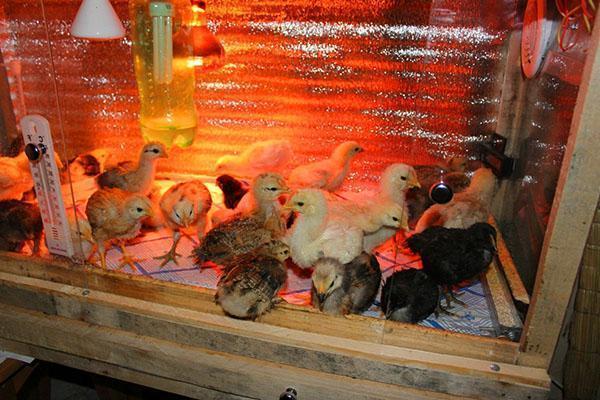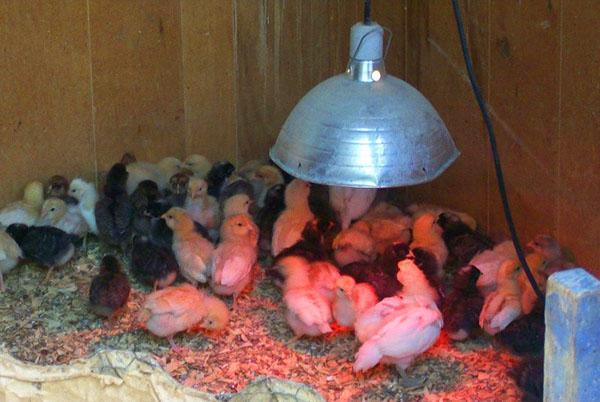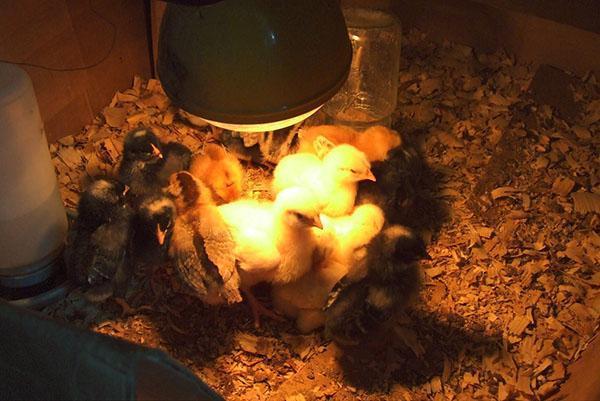Optimum temperature for keeping chicks in the first days of life
 Only chickens that are born require special attention and care. For quick adaptation and start of growth in the first days of life, the temperature for the chicks must be increased.
Only chickens that are born require special attention and care. For quick adaptation and start of growth in the first days of life, the temperature for the chicks must be increased.
If a brood hen is persistently near the chicks, it provides such "greenhouse" conditions. A chicken with babies 2-3 days after their appearance should be indoors, and then the family in the warm season is unhindered to walk, knowing that an adult bird will always save the chickens from cold and bad weather.
But what about when the chicks come from the incubator? Such chicks are more vulnerable, they have practically no natural resistance to fluctuations in humidity and temperature, and any mistake of the poultry farmer can become fatal. Therefore, as soon as possible after hatching, the chickens are transferred to a dry litter, covered from drafts, lit and heated.
Chick temperature

The well-being of pets can be judged not only by the readings of measuring instruments, but also by the behavior of the bird, taking into account its breed and age.
In comfortable conditions, the chicks are active, they move with pleasure, drink and feed, without straying into groups and without sitting in the corners of the cage:
- As soon as the chicks are kept below the temperature limit, or the chicks feel an unwanted draft, they try to snuggle closer to each other near the lamp or heater.
- When the indoor air becomes excessively hot, the opposite can be observed. The birds bristle their feathers or down, keep their beaks wide open, drink greedily and try to stay away from their fellow tribesmen, perching on the litter along the borders of the house or cage.

Both hypothermia and excessively hot air are a serious danger to chickens. The bird feeds worse and weakens, as a result, it becomes an easy prey for infections and other diseases.
Heating systems for chicks in the first days of life
For heating cells or the box use a variety of means. Small containers, where it is easy enough to maintain a comfortable temperature for chicks in the first days of life, can be warmed with:
- water or electric heating pad, protected from moisture;
- bottles of warm water wrapped in several layers of cotton, woolen or cotton fabric;
- incandescent lamps;
- one or two reflectors fixed out of the reach of chicks.
 Whatever the box is heated, you need to remember about safety, the ability of individual heat sources to cool down or, on the contrary, become excessively heated, and also that the heating of the air is most often uneven. The chick temperature will be warmer near a 3–6 ° C heater than in the opposite corner of the crate.
Whatever the box is heated, you need to remember about safety, the ability of individual heat sources to cool down or, on the contrary, become excessively heated, and also that the heating of the air is most often uneven. The chick temperature will be warmer near a 3–6 ° C heater than in the opposite corner of the crate.
Egg chicks are usually more mobile than their broiler counterparts.Therefore, to save money in the first few days, a large house for chicks can be divided into parts. This will not only save energy, but also help the little ones save precious energy. Heating a cage or box is necessary until the age of one month, then:
- in the cages, the temperature for chickens is set within 18 ° C;
- chicks live on deep litter when warmed up to 15 ° C.

Lighting mode for young chickens
In addition to maintaining an elevated temperature for chicks in the first days of life, constant lighting is important. In this simple way, the bird is encouraged to actively feed and grow. By daylight hours lasting 9-10 hours, they gradually come to the age of two months, while walking in the sun is very useful for chickens, as a measure of hardening and prevention of rickets.
The right temperature for the chicks, combined with adequate lighting and diet - the guarantee of rapid growth, good health and active weight gain.
Heating and lighting are organized in a variety of ways, but an increasing number of poultry farmers tend to favor red bulbs for heating chicks.
Using red lamps to heat chicks
 Infrared sources used in poultry houses must be of a safe, reliable design, protected from moisture penetration, possible shock, shock and curiosity of growing birds. We must not forget about the risk of fire, which will inevitably lead to dire consequences.
Infrared sources used in poultry houses must be of a safe, reliable design, protected from moisture penetration, possible shock, shock and curiosity of growing birds. We must not forget about the risk of fire, which will inevitably lead to dire consequences.
The infrared chick lamp is covered with a protective grille and suspended at a safe height. Today, poultry farmers are offered several options for such equipment.
The mirrored red chick heating lamp can be made with a transparent or red bulb. In the first case, the source gives not only heat, but also a luminous flux, in the second - almost all the energy consumed is used to generate heat. Such lamps have a sufficiently high power and a service life of up to 5 thousand hours. This allows you to reliably and uninterruptedly heat small chicks, without the fear that the lamp will fail at the most inopportune moment.
Ruby-domed lamps heat up instantly and, thanks to their reflectivity, help save up to a third of the incoming electricity. The light from such lamps for chickens is not an irritating factor; under it they grow well from the first days until the moment they are transferred to an adult bird.
 When installing lamps for heating chickens, you should pay attention to the fact that the parameters of the heat flux directly depend on the height of the radiation source:
When installing lamps for heating chickens, you should pay attention to the fact that the parameters of the heat flux directly depend on the height of the radiation source:
- From birth to one week of age, the lamp is fixed above the chicks at a height of 50 cm.
- In the second and third weeks, it is transferred higher, about 75 cm from the litter.
- Then the radiation sources are set at a meter height.
As a result of this transfer, the temperature of the chickens is lowered, and the lighting and heating area is significantly increased.
The use of red lamps to heat the chicks encourages rapid growth of the birds. Chicks feed more actively, gain weight better, they have good immunity and stable positive dynamics.
This effect is not accidental, since infrared radiation is as close as possible to what a bird would receive from the sun and free-range. In addition to the already proven red lamps, there are also combined devices that give an ultraviolet spectrum, which allows them to be used for disinfection.